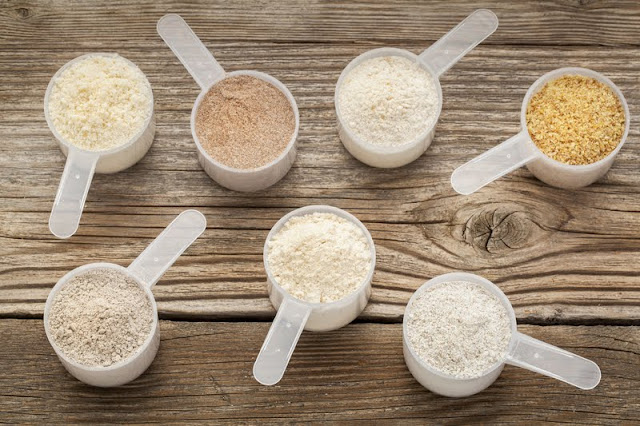Photo by theculinarycook.com
When it comes to baking, for most of the recipes, flour is the main ingredient. However, there are so many types of flour in the market, how do you choose which one to use? Here's a little research that I have done and summarised for reference.
The most common types of flour derived from wheat but it also derives from other things, such as rice or corn etc. Wheat, wholewheat, bleached, gluten-free....when it comes to baking with flour, there are too many choices than ever. They are all fantastic for baking, but, they differ in taste and texture slightly. Thus, it's good to have a little information about each one.
A little bit of plant biology first. Wheat is separated into 3 parts, namely, the bran, the germ and the endosperm. The bran is the hard outer shell of wheat head. The germ is found very inside of wheat head. The endosperm is the inside body of the wheat head and makes up most of the mass of the wheat head. They are recombined differently to create different flour type.
Wholewheat flour is made from grinding all the 3 parts together and nothing is actually discarded. Thus, it's more nutritious and healthier than white flour. It has got a lot of roughage (dietary fiber) which gives quite a dense texture.
White flour is the most type of flour used by bakers. It's milled with the bran and germ removed, leaving behind the endosperm. Thus, it is more shelf-stable than wholewheat flour. However, as a result, it has a milder flavour and less nutritive qualities because of the lack of bran and germ which are contained with fiber and protein.
The flour is further classified based on the amount of gluten or protein that they contain, usually differs from 5% to 15%. Gluten in flour is what provides texture in baked goods. High gluten flour are usually used for bread and not suitable for cake or pastries. Gluten gives bread an elastic, coarse, chewy texture and helps it rise.
Gluten content:
1) Cake flour
Cake flour contains 7.5-8.5% gluten. This type of flour creates the lightest cakes with the most tender crumb.
2) Self-raising flour
This is most probably the flour that most people would use at home, simply because it saves our time to measure baking powder and salt because for every cup of flour, it contains 1 and 1/2 teaspoon of baking powder and about half a teaspoon of salt. It contains 8.5-9.5% gluten which gives the tenderness and makes it absolutely fantastic to use in everything; muffins, cakes, biscuits, you name it.
3) All purpose flour
The name says it all. This flour is great for about everything, literally! I use this type of flour basically for everything! ;) It contains 10-12% gluten which allows the flour to be sturdy enough to hold its structure in bread and light enough to produce an easy crumb in cake.
4) Bread flour
It's really high in gluten of 12-14%. The bread is only activated once it's moisten. It's only suitable for bread making and not for cakes or cookies.
5) High gluten flour
This type of flour creates even harder and chewier texture than bread flour because it contains 14-15% of gluten. It's usually used by commercial bakeries to create chewy baked goods such as hearty artisan breads, pizza crusts and bagels. Definitely not for use in making cakes and cookies.
Now, you can see the many ways different wheat flours are used in different baked goods based on the gluten content. I have only covered the top 5 used flours. There are still a lot more other types of flour out there in the marker. Try experimenting with these different flour types to reach the next level in baking world.
All the best!

No comments:
Post a Comment